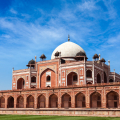HUMAYUN'S TOMB
Tomb topped by a double-domed dome, prototype of Mughal garden tombs built in 1565 by a Persian architect.
It is undoubtedly the most beautiful monument of Delhi, which combines finesse and grandeur of architecture. Prototype of the Mughal garden tombs, this immense mausoleum in red sandstone and white marble inspired the Taj Mahal. It prefigures the Mughal architecture dear to Shah Jahan, made of inlay in the stone. The site includes several tombs as well as sumptuous gardens with water features. The best time to visit is early in the morning or late in the day when the soft light is filtered through the jialis, the openwork stone screens. Humayun's tomb has been on the Unesco World Heritage list since 1993.
Tomb of Isa Khan. Near the entrance of the mausoleum (south-east) stands the tomb of Isa Khan, general of the famous Sher Shah who dethroned Humayun for five years. It is built in the octagonal style of the Lodi tombs and predates the emperor's tomb by twenty years. On the same side of the park, you will see the ruins of the Arab-ki-Sarai, a caravanserai in which the workers employed in the construction of the emperor's mausoleum were apparently housed.
The tomb of Humayun. This huge cube of red sandstone erected on a platform was built in 1565, at the request of the Mughal emperor's widow. She asked a Persian architect to build the mausoleum. One can find typical architectural elements such as the double dome, a technique used in Persia since the 13th century, or the pishtak, a portal in the form of a projecting arch. The roofs on either side of the dome are surmounted by chhatris, stone bells resting on slender pillars. The mausoleum is placed at the end of a charbagh, a garden with four clumps, crossed in its center by canals that feed basins and fountains. Under the white marble dome surrounded by kiosks, you enter the central octagonal chamber where the emperor's cenotaph is located. The tomb itself is actually in a crypt that is off limits to the public. The finely crafted stucco dome still retains traces of the original paint. In the annexed halls directly overlooking the esplanade, you will see the tombs of the members of the dynasty. These rooms are closed by thin jalis through which the light filters.
The site underwent a thorough renovation in 2013 thanks to the Aga Khan Foundation. Six years of construction and 200,000 days of work were necessary. In particular, the work enabled the hydraulic system to be restored and the burial chamber to be restored.
Did you know? This review was written by our professional authors.
Members' reviews on HUMAYUN'S TOMB
The ratings and reviews below reflect the subjective opinions of members and not the opinion of The Little Witty.












A voir absolument